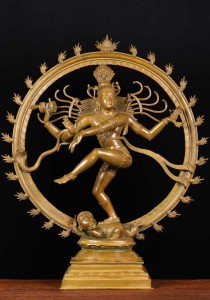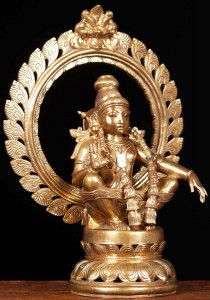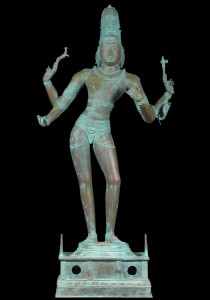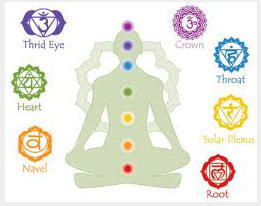
Most of the images and sculpture of Lord Shiva depict the River Ganga flowing from his matted hair. As with all symbols within Hindu iconography there is an interesting tale behind Shiva and the Hindu goddess Ganga. According to Hindu mythology, there was a powerful king in India named Sagar. He decided to conduct Ashwamedha Yagya, a horse sacrifice, to declare his supremacy over the gods. The king of Heaven, Indra grew jealous of King Sagar and decided to steal the ritual horse. Indra successfully abducted the horse and tied him in the ashram of Sage Kapil, who was silently meditating for many years. King Sagar ordered his 60,000 sons to search and find his sacrificial horse. After a long search they found the horse tied at the ashram and began assaulting the great sage thinking he was the culprit who stole the horse. The sage awoke from his trance and in his anger started to destroy all the sons of king Sagar who were accosting him. Anshuman, the grandson of King Sagar, pleaded for forgiveness. The sage told him that he could save his life by bringing the sacred river Ganga down from the heavens to purify the souls of him and his ancestors and help them to attain nirvana.
King Dilip, son of Anshuman pleaded with Lord Brahma to help them bring the Ganga to earth. He failed to appease Brahma so he passed the task to his son, Bhagiratha. Bhagiratha was able to please Brahma, who ordered Ganga to descent to Earth. The furious Ganga felt this as an insult and decided to destroy Earth with her force while descending from heaven. Bhagiratha was warned by Brahma that earth will not be able to hold Ganga while descending from heaven, so he must seek the help of Lord Shiva, the only one who can withstand the power of Ganga. Bhagiratha pleaded with Lord Shiva to help him and Shiva agreed to receive Ganga in his matted locks. Ganga was arrogant and tried to drown Shiva by pushing him to the core of the earth, but the mighty Shiva easily held her in his locks. Shiva’s tie was so strong that Ganga became helpless.
Lord Shiva wanted to teach Ganga a lesson, but instead released her in seven streams as he was satisfied with the prayers of Bhagiratha. The seven streams of Ganga are Bhagirathi, Janhvi, Bhilangana, Mandakini, Rishiganga, Saraswati and Alaknanda. Ganga became calm and followed Bhagiratha, who lead her to his ancestors and with her purity, released their souls.
There are a number of legends associated with Ganga and the different names she has at different places. This is but one.
Ganga is considered to be the most sacred river in India and it originates from the depths of Gangotri glacier. Ganga, otherwise known as Ganges, brings purity to human life. By bathing in her sacred waters one is purified to the core of their being.
Bhagiratha’s great effort in bringing Ganga to earth is known as “Bhagiratha Prayatna”. What would you consider to be the noble quality of Bhagiratha – his strong affection to his ancestors or his determination to meet any challenges to attain the ultimate goal?




